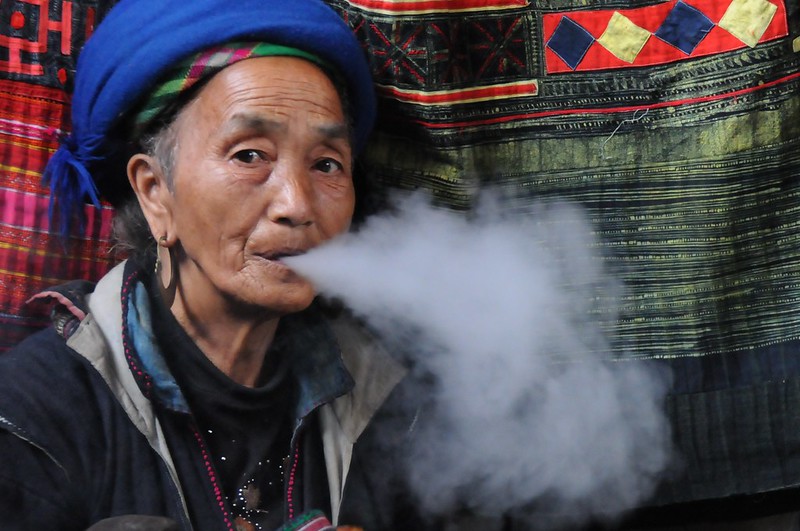Tobacco in Vietnam: A Cause and a Symptom of Poverty
 Vietnam is considered a developing country with a lower middle-income economy. Historically, the Vietnamese considered tobacco a means to materially signify “social status, convey respect and support social rituals.” Today, Vietnam is considered one of the highest tobacco-consuming nations in the world, with more than 40,000 premature Vietnamese deaths per year attributed to smoking.
Vietnam is considered a developing country with a lower middle-income economy. Historically, the Vietnamese considered tobacco a means to materially signify “social status, convey respect and support social rituals.” Today, Vietnam is considered one of the highest tobacco-consuming nations in the world, with more than 40,000 premature Vietnamese deaths per year attributed to smoking.
Smoking as a Symptom of Poverty
Socioeconomic inequality can be inherently linked to levels of tobacco consumption. A 2012 study by the National Institute of Health found that poorer men in society were 2.5 more likely to smoke than the wealthier male population. The World Health Organization (WHO) Framework Convention on Tobacco Control found that more than “80% of the world’s smokers” reside in “low or middle-income countries.” This is supported by the fact that only 29.1% of Vietnam’s wealthier quintiles smoke daily, compared to 47.9% in the poorer sectors.
The damaging physical and mental impacts of cigarette use further support an argument for tobacco as an indicator of poverty. Nicotine addiction results in Vietnam’s most impoverished citizens consuming tobacco to “reduce the stress of social isolation, economic hardship, prior trauma and the loss of power and status.” Vietnam’s predominantly higher rates of tobacco consumption can be correlated directly with its status as a lower economically developed country.
Smoking as a Cause of Poverty
Cigarettes are not only an indicator of poverty in Vietnam but also a contributing cause of such. A 2018 study found that tobacco-related expenditure increased the number of Vietnamese people considered poor by 305,090 (0.31% of the country’s population). Expenditure on cigarettes exacerbates already stretched budgets in low-income households. A WHO study identified three characteristics of tobacco-related expenses that could amplify the troubles of necessitous households:
- the reduction of disposable income due to tobacco-related purchases,
- the loss of household income due to premature mortality and
- higher expenditure on health care expenses due to the health implications of smoking.
The morbidity and mortality associated with cigarettes aggravates the financial struggles of tobacco-smoking households. Developing countries, like Vietnam, do not have the health care infrastructures in place to support the prevalence of tobacco-induced ailments. Vietnam’s “weak” social insurance system and “expensive” health care means there is a higher risk of smokers and their families falling below the poverty line.
National and International Tobacco Corporations
The tobacco industry employs various tactics to maximize profits, both nationally and internationally. In 2022, a state-owned company, Vietnam National Tobacco Corporation (Vinataba), had the largest share in the national Vietnamese cigarette market, at 58%. This contextualizes the finding that Vietnam has one of the lowest tobacco taxes in Southeast Asia, higher only than Laos, Cambodia and Myanmar.
In 2021, Vietnam imported more than $242 million worth of tobacco from companies such as Philip Morris International (PMI) and Japan Tobacco International (JTI). The multinational tobacco industry recognizes the female population of Vietnam as an untapped industry. As a result, these companies relentlessly target this societal sector through advertising campaigns that associate cigarettes with “fashion, glamor, independence and empowerment.”
However, female tobacco consumption in Vietnam is significantly lower than the male population, at an estimated 4.3% of women compared to a staggering 72.8% of men. While tobacco use is largely gendered, it is recorded that 48% of women are exposed to second-hand tobacco smoke at home and 25% suffer exposure at work. It is also documented that 19,000 Vietnamese citizens have died as a result of passive smoking, with 60% of these being women.
Steps Toward a Smoke-Free Future
The Vietnam National Tobacco Harm Prevention and Control Program aims to reduce tobacco use in Vietnam by raising public awareness of the social, financial, environmental and health consequences of cigarettes. It focuses primarily on younger age groups (between 15 and 24 years old). The program has numerous aims, including a reduction of passive smoking by 30% in the workplace, 75% in restaurants and 80% in cafes and bars between 2026 and 2030.
Through collaborations with international organizations and liaison with local agencies, this initiative has launched media campaigns and school initiatives that promote a smoke-free future for upcoming generations in Vietnam.
Final Remark
Smoking is an epidemic in Vietnam and can be correlated directly with poverty levels. However, the health dangers and economic implications of smoking are being recognized, a recognition that has seen measurable improvements in tobacco-related repercussions. From 2015 to 2022, Vietnam has reduced the number of smokers by 0.85, preventing 280,000 premature deaths and saving 1.277 trillion Vietnamese dongs ($54.4 million). Tackling tobacco abuse has the inherent impact of alleviating poverty in marginalized Vietnamese communities.
– Thea Carter
Thea is based in London, UK and focuses on Global Health for The Borgen Project.
Photo: Flickr
